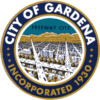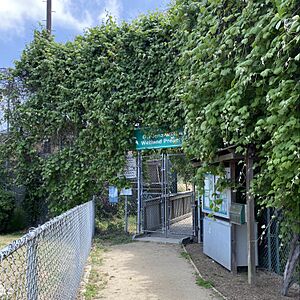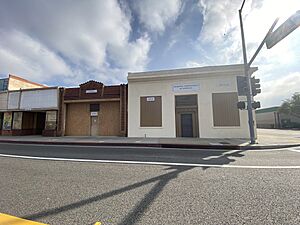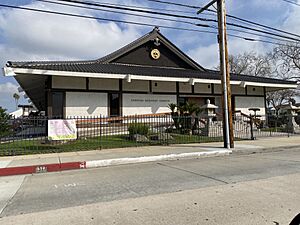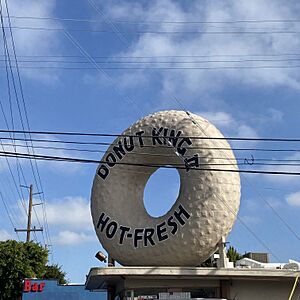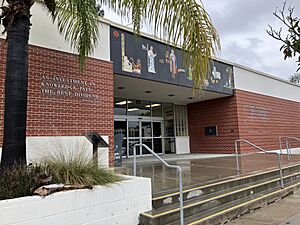Gardena, California facts for kids
Quick facts for kids
Gardena, California
|
|||
|---|---|---|---|
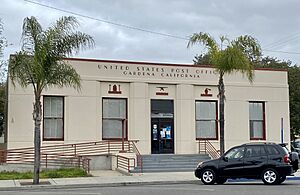
The United States Post Office in Gardena
|
|||
|
|||
| Nickname(s):
"Freeway City"
|
|||
| Motto(s):
"The City of Opportunity!"
|
|||
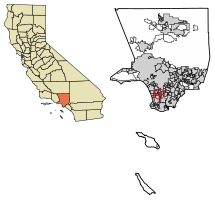
Location of Gardena in Los Angeles County, California
|
|||
| Country | |||
| State | |||
| County | Los Angeles | ||
| Incorporated | September 11, 1930 | ||
| Area | |||
| • Total | 5.86 sq mi (15.19 km2) | ||
| • Land | 5.83 sq mi (15.10 km2) | ||
| • Water | 0.04 sq mi (0.09 km2) 0.61% | ||
| Elevation | 49 ft (15 m) | ||
| Population
(2020)
|
|||
| • Total | 61,027 | ||
| • Density | 10,414/sq mi (4,017.6/km2) | ||
| Time zone | UTC−8 (PST) | ||
| • Summer (DST) | UTC−7 (PDT) | ||
| ZIP Codes |
90247–90249
|
||
| Area codes | 310/424 | ||
| FIPS code | 06-28168 | ||
| GNIS feature IDs | 1660664, 2410570 | ||
Gardena is a city in the South Bay area of Los Angeles County, California. In 2020, about 61,027 people lived there. Gardena is known for having a large Japanese American population. This community helps make the South Bay area a hub for Japanese businesses in the United States.
Contents
History of Gardena

Long ago, the Tongva people lived in the area that is now Gardena. They hunted and fished there. These Native Americans are thought to be descendants of people who came to North America about 10,000 years ago.
In 1784, a Spanish soldier named Juan Jose Dominguez received a large land grant called the Rancho San Pedro. This land included the Gardena Valley. After the American Civil War, soldiers and farmers bought parts of this land.
In 1869, a general named William Starke Rosecrans bought a big piece of land. This land was later divided and sold. In 1887, real estate developers started planning the town of Gardena. They expected a new railway to arrive soon. The first settlement in Gardena was started by Spencer Roane Thorpe that same year.
Why was it called "Berryland"?
Some people think Gardena got its name because it was a "green spot" during the dry season. It was located between Los Angeles and the ocean. The city was also called "Berryland" because it had many acres of berries. Each May, they held a fun Strawberry Day Festival and Parade. However, the berry farms faced challenges during World War I.
Becoming a City
Many Japanese Americans settled in Gardena over the years. To avoid a high county tax on a planned park, Gardena decided to become its own city. Gardena officially became a city on September 11, 1930.
For many years, from 1936 to 1980, Gardena was one of the few places where cardrooms (places for card games) were legal. The taxes from these cardrooms helped pay for a large part of the city's yearly budget. As the area grew, many Japanese American families moved into new homes in Gardena.
Where is Gardena?
Gardena covers about 5.9 square miles (15.3 square kilometers) of land. It has a special place called the Gardena Willows Wetland Preserve. This 9.4-acre (3.8-hectare) area is a natural marshland. Water comes up from underground all year, and many different plants grow there.
Gardena is surrounded by other communities:
- To the north: Athens
- To the east and south: Harbor Gateway (part of Los Angeles)
- To the southwest: Torrance
- To the west: Alondra Park
- To the northwest: Hawthorne
Some neighborhoods within Gardena include:
- Hermosillo
- Moneta
- Strawberry Park
People of Gardena
| Historical population | |||
|---|---|---|---|
| Census | Pop. | %± | |
| 1940 | 5,909 | — | |
| 1950 | 14,405 | 143.8% | |
| 1960 | 35,943 | 149.5% | |
| 1970 | 41,021 | 14.1% | |
| 1980 | 45,165 | 10.1% | |
| 1990 | 49,847 | 10.4% | |
| 2000 | 57,746 | 15.8% | |
| 2010 | 58,829 | 1.9% | |
| 2020 | 61,027 | 3.7% | |
| U.S. Decennial Census | |||
In 2010, Gardena had a population of 58,829 people. The city was quite diverse. About 24.6% of the people were White, 24.4% were African American, and 26.2% were Asian. Also, 37.7% of the population identified as Hispanic or Latino.
Most people in Gardena live in homes, not group housing. In 2010, there were 20,558 households. About 35% of these households had children under 18 living there. The average household had about 2.82 people.
Japanese American Community
Gardena has a very large Japanese American community. For a long time, it had the second-highest number of Japanese Americans in any U.S. city, after Honolulu. Now, the nearby city of Torrance has the most Japanese Americans in the mainland U.S.
The Japanese Cultural Institute (JCI) has been in Gardena since 1988. It offers many cultural and social activities for Japanese Americans.
Japanese immigrants were important to Gardena's early farming economy. They started schools like the Moneta Japanese Institute in 1911 and the Gardena Japanese School in 1916.
During World War II, in 1942, the U.S. military forced Japanese Americans from Gardena to move to internment camps.
After the war, the community rebuilt. In 1966, Kiyoto Ken Nakaoka became the first Nisei (a person born in America to Japanese parents) to join the city council. He later became Gardena's mayor in 1972.
Korean American Community
Gardena also has a growing Korean American community. In 1992, about 60% of the Korean population in the South Bay lived in Gardena and Torrance. Many Korean businesses chose Gardena because land was more affordable than in Torrance.
Economy and Jobs
Gardena is home to several important companies. Digital Manga, a company that publishes comics, has its main office here. Nissin Foods, known for its instant noodles, has its U.S. headquarters and a factory in Gardena. Marukai Corporation U.S.A., a Japanese supermarket chain, also has its main office in Gardena. Nissan's North American headquarters were in Gardena until 2006.
Major Employers
Here are some of the top employers in Gardena:
| # | Employer | # of Employees |
|---|---|---|
| 1 | United Parcel Service Inc. | 789 |
| 2 | Gardena Memorial Hospital | 750 |
| 3 | Nissin Foods | 550 |
| 4 | ... Casino | 465 |
| 5 | Air Fayre | 289 |
| 6 | Avcorp | 289 |
| 7 | Larry Flynt's Lucky Lady Casino | 245 |
| 8 | Southwest Offset Printing | 235 |
| 9 | Kindred Hospital South Bay | 225 |
| 10 | Target | 200 |
Education in Gardena
The Los Angeles Unified School District manages the public schools in Gardena.
Public Schools
Students in Gardena attend these middle schools:
- Peary Middle School
- Some areas can choose between Peary and Henry Clay Middle School.
The main high school for Gardena students is:
- Gardena High School
Private Schools
There are also private schools in Gardena:
- Junípero Serra High School (Catholic)
- Maria Regina Catholic School (K-8)
- St. Anthony of Padua School (K-8)
- Pacific Lutheran Jr./Sr. High School (grades 6-12)
- Gardena Christian Academy (PreK-2)
City Services
Public Services
The Gardena Office of Economic Development helps businesses set up in the city. It also helps employers find workers for different jobs.
The Gardena Police Department keeps the city safe. It has many police officers and support staff. The current Chief of Police is Michael Saffell.
The Los Angeles County Department of Health Services has health centers nearby that serve Gardena residents.
The United States Postal Service has several post offices in Gardena for mail services.
Libraries
Gardena has two public libraries:
- Gardena Mayme Dear Library
- Masao W. Satow Library (located just west of Gardena)
These libraries are part of the County of Los Angeles Public Library system. The Gardena Library was first formed in 1913. The current Gardena library building opened in 1964. The Satow library, named after a Japanese American community member, opened in 1977.
Transportation
The city runs its own bus service called GTrans. This helps people get around Gardena and nearby areas.
Famous People from Gardena
Many notable people have connections to Gardena:
- Paul Bannai, first Japanese American in the California State Legislature.
- Beau Bennett, a retired hockey player.
- Polly Bergen, actress and singer.
- Steven Bradford, first African American on the Gardena City Council.
- Enos Cabell, former baseball player.
- Wayne Collett, Olympic silver medalist in running.
- Dock Ellis, former baseball pitcher.
- Lisa Leslie, Olympic gold medalist and basketball player.
- Butch Patrick, actor from The Munsters.
- Art Pepper, famous jazz saxophonist.
- William Rosecrans, a Union general who owned land where Gardena now stands.
- Kevin A. Ross, TV judge.
- Daewon Song, professional skateboarder.
- George Stanich, Olympic bronze medalist in high jump.
- Tyga, rapper.
- Robert Woods, football wide receiver.
Sister Cities
Gardena has two sister cities, which are cities that have a special partnership:
 Huatabampo, Mexico
Huatabampo, Mexico Ichikawa, Japan
Ichikawa, Japan
See also
 In Spanish: Gardena (California) para niños
In Spanish: Gardena (California) para niños



